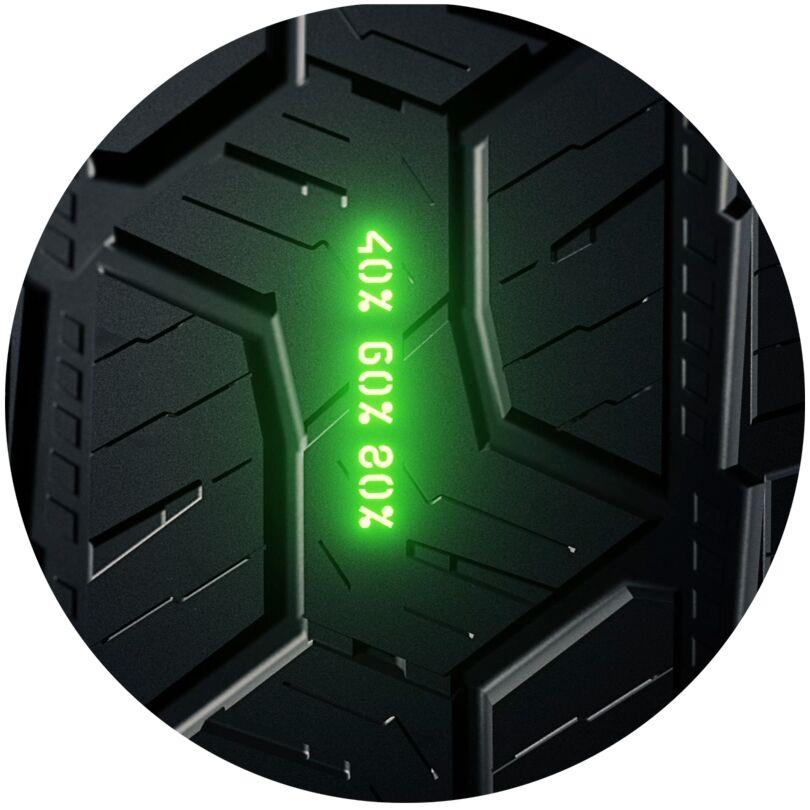
Tire wear can be determined by checking the tread depth. Take care of the condition of your winter tires and check their tread depth before winter.
Tires in good condition and of high quality are one of the main contributing factors to safe winter driving. Ensuring that your winter tires are not worn and have sufficient tread depth will both comply with the law and enhance road safety. Whether your car has studded or non-studded tires, check their condition at least when changing tires.
What is tire tread depth?
Tire tread depth is measured from its main grooves. These are the wide grooves in the middle of the tread whose depth decreases as the tires wear. There are requirements for tire wear and minimum tread depth, and a drivers are not allowed to deepen the grooves of their car's tires to extend the tire’s lifespan.
Drivers can test the tread depth themselves, for example with a two-euro coin. Their tires may also come with a wear indicator. The Nokian Tyres DSI (Driving Safety Indicator) wear indicator shows when the tire is too worn and should be replaced. Winter tires also have a snowflake symbol associated with the wear indicator. The symbol indicates that the tire is no longer safe in demanding winter conditions once it wears off the tire.
What is sufficient winter tire tread depth?
The minimum tread depth allowed by law and the tread depth that is safe for road safety are not the same thing. Although it would still be legal to drive with the tires, they may already be too worn to offer sufficient grip in demanding winter conditions. The legally prescribed minimum tread depth for winter tires is 3 mm, depending on the country. However, it is recommended not to drive on winter tires if their tread depth is less than 4 mm.
New winter tires have a tread depth of more than 8 mm and summer tyres around 8 mm. Sufficiently deep tread grooves ensure safe slush and aquaplaning properties. Your vehicle may also fail to pass regular inspection if the tires are too worn.
The usage period for winter tires is from the beginning of November to the end of March, as well as when weather or road conditions require their use. The importance of sufficient tread depth is particularly emphasized in winter tires, which must be able to provide sufficient grip on ice, slush, and snow. Even if the tires have studs or grip-enhancing sipes, these alone are not enough in difficult winter conditions and on slippery roads.
Measure tire tread depth with a two-euro coin
The exact tread depth of a winter tire cannot be measured just by looking at it. However, checking the sufficient tread depth is easy at home without any special tools. A two-euro coin is all you need. The silver outer edge of the coin is 4 mm wide. If this silver edge is hidden when placed in the main groove of the winter tire tread, there is still enough tread left on the tire.
The age of winter tires also matters
In brand new winter tires, the tread depth is more than 8 mm. However, tread depth alone does not tell the whole truth, and the driver must also take into account the tire’s age. As the tire ages, the grip properties of the tread compound deteriorate.
The general recommendation for tire age is 6 years in use and a total age of 10 years. The total age can be measured from the tire’s date of manufacture, which can be checked from the markings pressed on the sidewall. The first two numbers of this marking indicate the week of manufacture of the tire, and the latter numbers its year of manufacture. Even if less than 10 years have passed since the tire was manufactured, its lifespan should ideally be a maximum of six years. However, it is not always easy to assess the condition of your tires based solely on age, and the tire's grip and driving characteristics can deteriorate significantly even before the six year mark.
A good way to extend the lifespan of winter tires is to change their position each time the tires are changed from summer tires and back. Normally, the vehicle's driving tires wear about twice as fast as the freely rotating tires, so timely tire rotation under the car significantly improves the overall mileage of the tires.

A driver’s checklist for the winter
- There are minimum requirements for tire tread depth. For summer tires, this is 1.6 mm and for winter tires 1,6 mm to 5 mm, depending on the country. Always check local laws and regulations where you live. Check the requirements also if you plan to travel to other countries during the winter season.
- Even if the tread depth of the tires is still sufficient in the eyes of the law, the safety-enhancing features of both summer and winter tires begin to deteriorate as the tires wear out.
- Tread depth can be checked at home, for example with a two-euro coin. The tires may also have a wear indicator that tells about the tread depth.
- In addition to the tread depth of your tires, their manufacturing year and lifespan also affect their condition and safety.
- Check the tire markings. Winter-approved tires have the EU tire label for snow and ice grip.
Please remember that it is the driver’s responsibility to ensure their tires are safe and suitable for their vehicle and to follow the vehicle’s manufacturer´s guidelines for proper use and maintenance. Consult your closest Nokian Tyres dealer or your vehicle’s manufacturer for specific advice.


